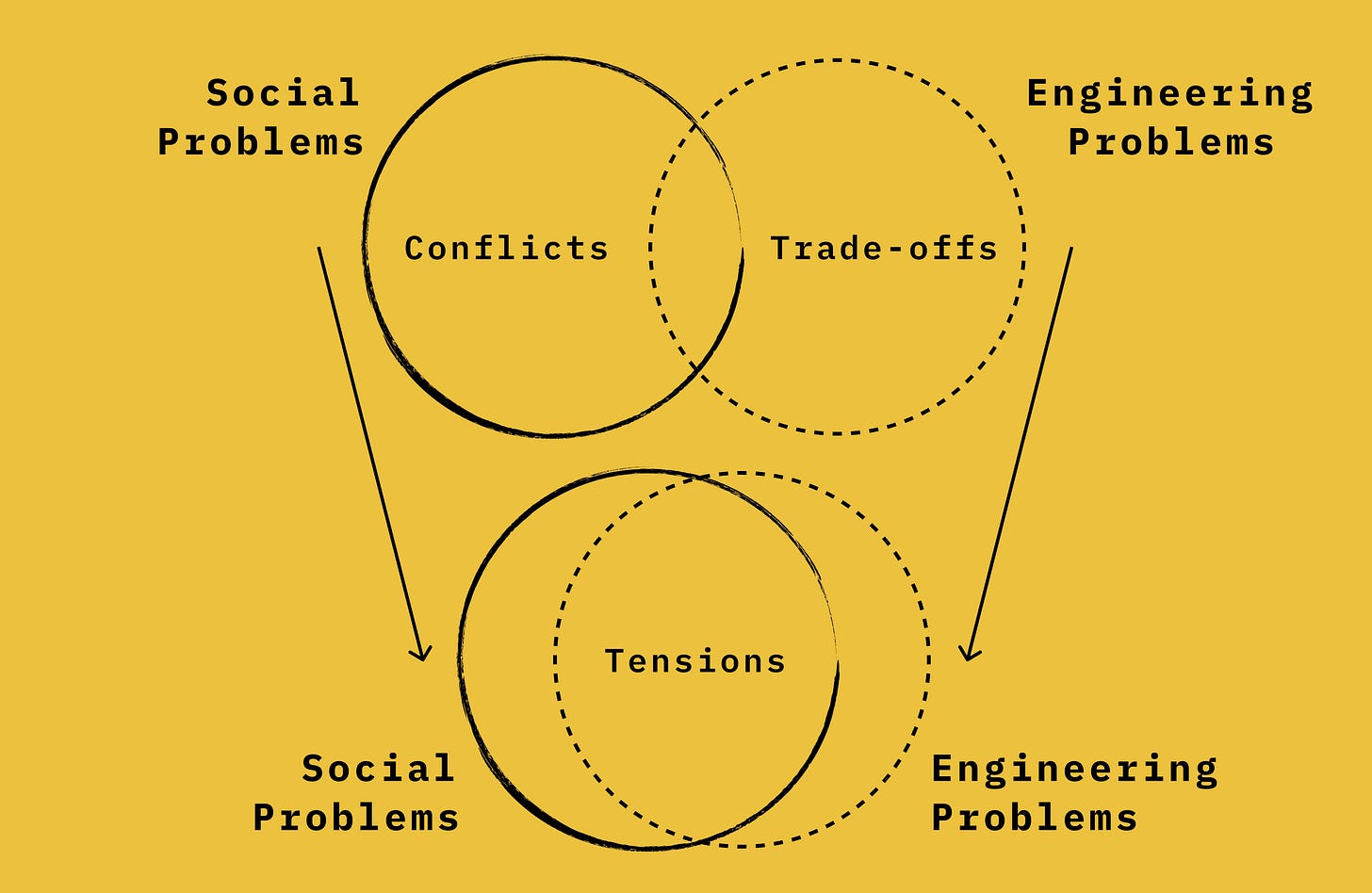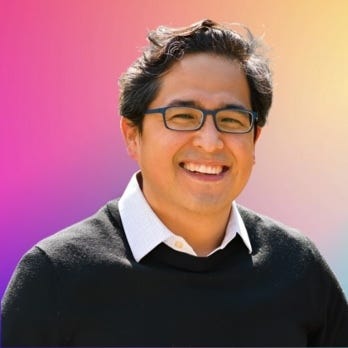Tension Landscapes
Issue #23: Spannungsfelds, Free Ticket to Edge City, SF Meetup
In this issue: A review of a popular political science paper that used tensions as a core part of its predictive mathematical model, plus notes on spannungsfelds and intellectual sparring. Also, join the meetup in San Francisco this Sunday, May 25th, at 10am, meet the final two teaching fellows, and apply for a ticket to Protocol Worlds.
Tensions have proven a useful idea in protocol design. To recap, a tension is a trade-off (an engineering concept) plus a conflict (a social concept). Indeed, they’re almost inseparable. The two domains have become more and more entangled, creating a potent spannungsfeld – German for “field of tensions”.
Take large language models (LLMs), which have upset things across the board. Companies, institutions, and individuals are scrambling to adapt. They try fixes on both sides. In social terms, there are usage declarations, policies, outright bans, and unionization efforts. Engineers tweak model weights, create new interfaces, or inject counterweight opinions (with heavy hands, as in the case of female popes and forced lectures on South Africa).
Two patterns to note here. First, solutions are almost always formulated in terms of either trade-offs or conflict, not both. Second, “this vs. that” thinking drives most of these ideas.
That latter cognitive habit is precisely the strength and weakness of tensions as a concept. Philosophers like Claude Lévi-Strauss have pointed out that we naturally think in oppositional binaries: raw vs. cooked, good vs. bad, safe vs. dangerous. Tensions piggyback on that. Rather than popularize a new way of thinking, which requires an impossible degree of luck, we can just upgrade our dualist frames.
In the case of LLMs, stakeholders face a series of fundamental trade-offs. A balance must be struct between prompt freedom vs. public safety. Cognitive skills vs. total productivity. High margins vs. large market share. Actors, like companies, parents, students, and teachers, differ in the balances they prefer. That creates conflict. A deeper definition of tensions can be found in Issue 003.
Robert Axelrod and D. Scott Bennett showcased this interdisciplinary-but-still-dualist approach in their 1993 paper A Landscape Theory of Aggregation. A standards war was one case study in the paper. For context, in 1987 multiple Unix operating system (OS) standards emerged from a froth of engineering trade-offs and conflict between actors. After two companies failed to impose a standard for Unix OS, competition broke out among the nine major players.
“Landscape theory predicts how aggregation will lead to alignments among actors (such as nations), whose leaders are myopic in their assessments and incremental in their actions. The predicted configurations are based upon the attempts of actors to minimize their frustration based upon their pairwise propensities to align with some actors and oppose others.”
Axelrod and Bennett thought, I believe correctly, that we take a piecemeal approach to problem-solving (we are myopic and incremental) and make decisions in reference to one other actor at a time (based on pairwise propensities). Hence, their framework is based on the idea of tensions. The below equation is the paper’s highlight. It looks complicated but the terms are simple.
Size (s), propensity (p), and distance (d) compose this predictive equation.
Let’s continue with the AI theme to explore this model qualitatively. Standard-setting efforts are alive and well in the AI industry. One notable landscape comprises the set of protocols that guide AI agent interactions. Semi-autonomous bots, powered by Claude, Gemini, etc. are beginning to query each other and now need their own kind of diplomatic protocol – just as internet protocols allowed computers to network.
This paper surveys candidate standards. To name a few:
A2A (Google)
agent.json (Wildcard AI)
ANP (ANP Community)
AITP (NEAR Foundation)
AComP (AI and Data)
AConP (Cisco)
ACP (BeeAI + IBM)
Agora (Marro et al.)
LMOS (Eclipse Foundation)
LOKA (CMU)
MCP (Anthropic)
Some major tech players, like Microsoft, Amazon, and Apple, are missing from this list. They haven’t proposed their own standard publicly, but because of their size (s – could be easily estimated with market capitalization), how these actors choose to align with others will deeply affect the tension landscape. Some propensities (p) could already be estimated – Microsoft invested at least $13 billion into OpenAI and has adopted MCP; Apple has a reputation for walled garden strategies; Amazon mentions a protocol standard used by its Bedrock Agents and is an investor in Anthropic. Further, companies have different specializations – in terms of capability, opposites will tend to attract (e.g., an infrastructure provider pair is are unlikely).
Distance (d) is also calculated using pairs. OpenAI and ANP Community are based in the U.S. and China, respectively, which hints at fundamental differences with regards to how they might be pressured from regulators on key trade-offs in the landscape. Amazon and Anthropic could be distant with regards to their trade-off preferences for safety. Others actors, like open-source communities, may hold similar preferences.
This is where simple, tension-based frameworks like landscape theory shine. There’s sufficient depth for quantitative analysis, and even without numbers (which you could estimate, but it’s still a bit early) we can start to paint a picture of how this protocol competition might play out. For example, OpenAI and Microsoft have composed an early alliance and use MCP, and will likely be joined by Amazon – a large investor in Anthropic; Apple will maintain its walled garden; separate alliances may form in Europe and in China due to a combination of regulatory and security concerns.
Axelrod and Bennett showed that it’s possible to add nuance to dualistic thinking through quantitative rigor, and by combining trade-offs and conflict to create tension landscapes, or spannungsfelds – a German term in electrical engineering that means “field of tensions”.
However, you don’t need to mathematize tensions for them to be useful. The idea of a tension is already intuitive based on how we already think, so it holds promise as a new tradition of an existing discipline: intellectual sparring.
Mental Martial Arts
The Summer of Protocols community will attend Edge Esmeralda from May 25 - 31 (you can apply to join) to develop protocol studies courses and run a series of open workshops. One session will be a tensions game. It’s a way to sharpen your thinking about the future by exploring central tensions in various scenarios. For example, in the case of the Ethereum protocol, ossification vs. functional escape velocity. Or, in the case of a startup, tyranny of the marginal user vs. tyranny of a visionary.
I ran a daily version of this game at Edge City Lanna last year in Chiang Mai. One reason pop-up cities are so interesting is because they’re protocol sandboxes. Tradition and innovation are on level ground, equally up for trial. It’s a rare opportunity to make impactful design choices about the protocols that shape day-to-day life.
"A major component of the work of protocol whisperers is to manage constantly shifting tensions at an ecosystem level, rather than within a single organization."
- Intro to the Protocol Reader
The deeper your knowledge of a city’s tension landscape, the better your ability to make good management decisions. Same goes for spannungsfelds of organizations or ecosystems; humans, technologies, organisms, and pieces of content and code and nature constantly generate new dilemmas and battles through their interactions.
Even something as simple as a peanut allergy can be portrayed as a tension. Rising rates of dangerous allergic reactions to peanuts have been a problem in Europe and North America. Ignoring that trend would have been grossly negligent. But a full fix also backfired. When schools and parents implemented avoidance strategies, reaction rates actually went up. Then, improved protocols for allergen exposure, like Learn Early About Peanuts (LEAP), improved oral tolerance by huge percentages (~75%).

The immediate damages of doing nothing were obvious. Why weren’t the second-order effects of avoidance policies obvious? It’s possible that if there was better literacy around tensions and protocols, we might have arrived at LEAP sooner.
Intellectual sparring – where partners push each other to think deeply, consider edge cases, weak points, second order effects, etc. – is a way to develop that literacy. To be a better protocol whisperer, identify a scenario and its central tension(s) and discuss it. Consider when the trade-off is taken to either extreme, failure modes, how actors interact and align, and explore existing protocols. For a detailed example of this process, read the case study in Issue 003: One Tension to Rule Them All.
The world is full of tensions that require ongoing attention. And the future will be composed of many new things – it won’t be “today, but with flying cars” or “1940 with 2025 technology”. Tensions games exercise your ability to navigate multiple changing things at once. Conflict can be incredibly generative if managed well. As we turn into a confluence of chaotic forces – AI, climate change, and struggles over state capacity – protocol whisperers are already in high demand and short supply.
SF Meetup & Tickets to Protocol Worlds
Join about ten SoPers for coffee this Sunday In San Francisco. We’re headed to Jane on Filmore at 10am on May 25th to chat protocols, sci-fi, tech futures, hardened commons, memory, AI, climate, and more. Stop by for some frontier conversations and to make some connections!
Please RSVP here. Meetup coordination is on Discord in #general – head there to ask questions and stay in the loop.
By the way, you could join our retreat at Edge Esmeralda. Seventeen SoPers, including 7 fellows, 6 alumni, and 4 organizers will be in Healdsburg during Week 1 (from May 25-31). Fellows and alumni will design courses and host a series of public workshops and classes. We have one spot left, which includes a ticket and a room at Hotel Trio. Want to get involved in building the field? To apply for to join, please share the following in #pitches on the SoP Discord:
What’s your background? Why do you want to join?
What’s protocol-related topic that you could host session, workshop, or talk on?
SoP25 Spotlight
This week’s double feature marks the end of the SoP25 spotlight series, and you can learn more about all the fellows at summerofprotocols.com
Andrés Monroy-Hernández is an associate professor of Computer Science at Princeton University. Previously, he led a Social Augmented Reality lab at Snap Inc. and was a social computing researcher at Microsoft Research. He was named one of the 35 Innovators under 35 by the MIT Technology Review and one of the most influential Latinos in Tech by CNET. Andrés holds a master’s and Ph.D. from MIT, where he led the creation of the Scratch online community. https://www.andresmh.com
Ben Zucker is an experimental composer and performer, interested in music’s unique capacities to speculate on systems of change as a rigorous, dynamic play of contemplation and visceral immersion in sonic extremes. This speculation started from a background in jazz and theater, and has extended to include the intersections of philosophy of language and improvisation, arts and platform capitalism, and object-oriented ontology’s application to musical creation.
His creative work includes “stirring compositions…built on a lifetime of musical curiosity” (Chicago Reader), and performances on vibraphone, brass, keys, voice, and electronics across styles. This intentionally diverse practice has included highlights such as compositions featured at the Berlin Philharmonie, London Roundhouse, and in PBS documentaries, residencies with OneBeat and the Stockholm EMS, and collaborations with groundbreaking musical figures ranging from Anthony Braxton to Sudan Archives. Deeply invested in the structural elements of musical life, their career has also involved extensive engagement with labor organizing, education, and project management. He lives in Chicago, working as a freelance artist, lecturer at Roosevelt University, President of New Music Chicago, and curator for Elastic Arts’ Improvised Music Series. More can be found and experienced at www.benzuckersounds.com.







